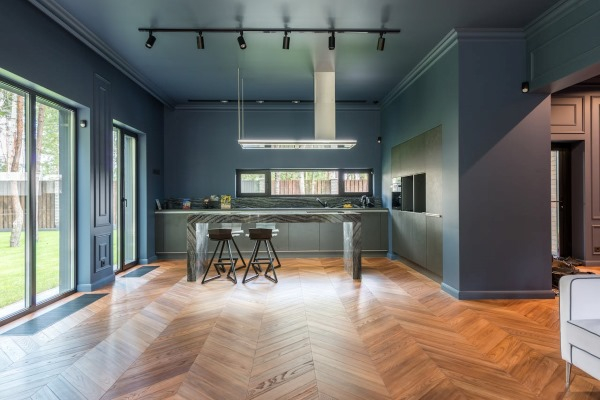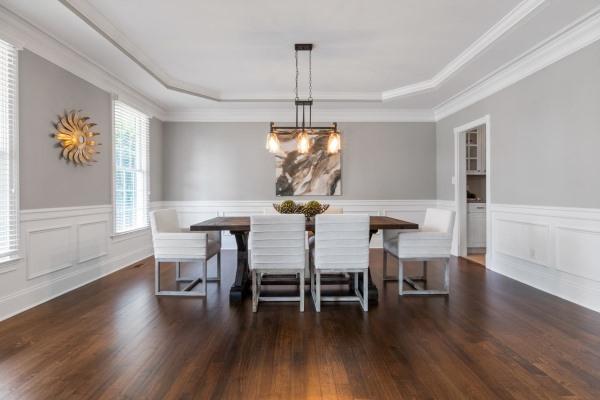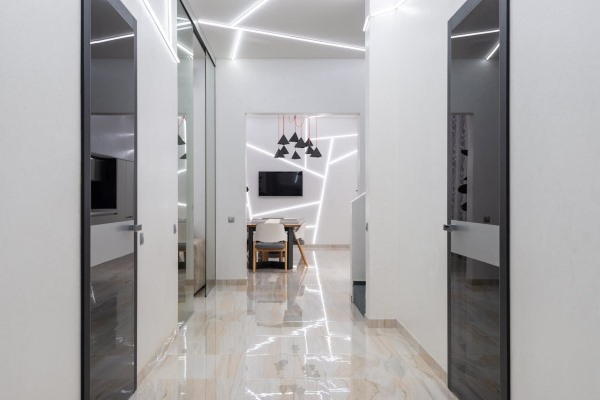When it comes to home renovations, few decisions are as impactful as choosing the right flooring. Whether you're redoing your kitchen, updating your living room, or sprucing up your bathroom, the type of flooring you choose can completely transform the look and feel of your space. Let's dive into some popular flooring options, explore their pros and cons, and discover where they shine best in your home.
1. Hardwood Flooring
Pros: Hardwood flooring is a classic choice that never goes out of style. It's known for its beauty, durability, and the ability to increase your home's value. With proper care, hardwood floors can last for decades. They come in a variety of wood types, finishes, and plank sizes, allowing for a high level of customization.
Cons: Hardwood can be quite expensive, both in terms of materials and installation. It's also susceptible to scratches, dents, and water damage. Regular maintenance, such as refinishing and polishing, is required to keep it looking its best.
Best For: Living rooms, dining rooms, and bedrooms—spaces where you want to showcase elegance and warmth. However, it’s not ideal for high-moisture areas like bathrooms or basements unless you're using engineered wood.
Tips: If you have pets or children, consider a harder wood like oak or maple to minimize scratches. Using area rugs can also help protect your floors in high-traffic areas.

2. Laminate Flooring
Pros: Laminate flooring offers the look of hardwood at a fraction of the cost. It's easy to install, often with a click-and-lock system, making it a great option for DIY enthusiasts. Laminate is also resistant to scratches and stains, making it a practical choice for busy households.
Cons: While it's durable, laminate is not as long-lasting as hardwood. It can’t be refinished, so once it's worn out, it must be replaced. It's also sensitive to water, which can cause it to swell and warp.
Best For: Living rooms, bedrooms, and hallways—areas where you want the appearance of wood without the high cost. Avoid using it in bathrooms or kitchens where moisture is prevalent.
Tips: Look for laminate with a high AC rating (Abrasion Criteria) for better durability, especially in high-traffic areas.

3. Vinyl Flooring
Pros: Vinyl is a versatile and affordable option that has improved significantly in quality over the years. It’s available in planks, tiles, and sheets, mimicking the look of wood, stone, or tile. Vinyl is water-resistant, making it a good choice for moisture-prone areas. It's also soft underfoot, which can be more comfortable to walk on.
Cons: Vinyl can emit volatile organic compounds (VOCs), which may be a concern for those with respiratory issues. While it’s durable, it can be prone to scratches and gouges, especially from sharp objects.
Best For: Kitchens, bathrooms, and basements—places where water and spills are common. It's also a good choice for laundry rooms and mudrooms.
Tips: Opt for luxury vinyl planks (LVP) or luxury vinyl tiles (LVT) for a more authentic look and greater durability. Check for low-VOC options if indoor air quality is a concern.
4. Tile Flooring
Pros: Tile is one of the most durable flooring options available. It’s resistant to water, stains, and scratches, making it perfect for high-traffic and moisture-prone areas. Tile comes in a wide range of materials, including ceramic, porcelain, and natural stone, allowing for endless design possibilities.
Cons: Tile can be cold and hard underfoot, which may not be comfortable in colder climates. It can also be slippery when wet, posing a potential safety hazard. Grout lines can become dirty and require regular cleaning.
Best For: Bathrooms, kitchens, entryways, and mudrooms—anywhere that needs a durable, water-resistant surface. It's also great for outdoor spaces like patios.
Tips: Choose textured or matte-finish tiles to reduce slipperiness. Use a dark-colored grout to minimize the appearance of stains and dirt.

5. Carpet Flooring
Pros: Carpet offers comfort and warmth, making it a cozy choice for many homes. It's available in a variety of colors, textures, and patterns, allowing you to match it to any decor style. Carpet also provides sound insulation, which can be beneficial in multi-story homes.
Cons: Carpet can stain easily and trap dust, allergens, and pet dander, which may not be ideal for allergy sufferers. It requires regular cleaning and maintenance to keep it looking fresh. Carpet also tends to wear out faster than other flooring options.
Best For: Bedrooms, living rooms, and family rooms—places where comfort and warmth are a priority. It's less suitable for kitchens, bathrooms, or entryways where spills and dirt are common.
Tips: Choose a high-quality, stain-resistant carpet for longevity. Regular vacuuming and professional cleaning can extend the life of your carpet.

6. Cork Flooring
Pros: Cork is a unique and eco-friendly flooring option. It's soft, providing comfort underfoot, and has natural sound-dampening properties. Cork is also hypoallergenic and resistant to mold and mildew. Its natural insulation properties help keep rooms warm.
Cons: Cork is not as durable as other flooring options. It can be scratched easily and may fade when exposed to direct sunlight. Water can also damage cork if it's not properly sealed.
Best For: Bedrooms, living rooms, and offices—areas where comfort and warmth are desired. Avoid using cork in bathrooms or basements where moisture can be an issue.
Tips: Use curtains or blinds to protect cork floors from direct sunlight. Consider resealing cork floors every few years to maintain their water resistance.
7. Bamboo Flooring
Pros: Bamboo is a sustainable and eco-friendly alternative to traditional hardwood. It's durable and can be refinished like hardwood. Bamboo flooring is available in various styles and colors, from natural light tones to darker, more dramatic shades.
Cons: Bamboo can be prone to scratches and dents. It can also be sensitive to changes in humidity and temperature, which can cause it to expand or contract. Not all bamboo flooring is created equal—quality can vary significantly.
Best For: Living rooms, bedrooms, and hallways—areas where you want a stylish and environmentally friendly flooring option. Avoid high-moisture areas like bathrooms.
Tips: Choose high-quality, solid bamboo flooring rather than cheaper, lower-quality options. Look for bamboo that has been harvested sustainably.
8. Concrete Flooring
Pros: Concrete is incredibly durable and long-lasting. It’s low-maintenance and can be customized with stains, dyes, and textures to create a variety of looks. Concrete floors are also hypoallergenic and resistant to water and stains.
Cons: Concrete can be hard and cold underfoot, which may not be comfortable for extended periods. It can also crack over time and may require sealing to prevent staining.
Best For: Basements, garages, and modern or industrial-style homes. It's also great for patios and outdoor spaces.
Tips: Use area rugs to add warmth and comfort to concrete floors. Regular sealing can help protect the surface and extend its lifespan.
FAQ
What is the most durable type of flooring?
Tile and concrete are among the most durable flooring options. Both are resistant to water, stains, and scratches, making them ideal for high-traffic and moisture-prone areas. Hardwood is also durable, but it may require refinishing over time to maintain its appearance.
Which flooring is best for households with pets?
For pet-friendly homes, consider laminate, vinyl, or tile flooring. These options are resistant to scratches and easy to clean. Avoid softer materials like carpet or cork, as they can trap pet hair and are more prone to damage.
What flooring is easiest to maintain?
Vinyl and tile are among the easiest to maintain. They are resistant to stains and water and require minimal upkeep—just regular sweeping and occasional mopping. Hardwood requires more maintenance, such as refinishing and polishing, while carpet needs regular vacuuming and professional cleaning.
Can hardwood flooring be installed in kitchens or bathrooms?
While hardwood is a beautiful choice, it’s not the best option for kitchens or bathrooms due to its susceptibility to water damage. If you love the look of wood but need moisture resistance, consider engineered hardwood or wood-look tile.
Is it possible to install flooring by myself, or should I hire a professional?
Some flooring types, like laminate and vinyl, are designed for easy DIY installation, often using a click-and-lock system. However, more complex materials like hardwood, tile, or concrete may require professional installation to ensure the best results and avoid costly mistakes.
How do I choose the right color or style of flooring?
Consider the overall aesthetic of your home. Light-colored flooring can make a space feel larger and more open, while dark flooring adds warmth and coziness. Think about your furniture, wall colors, and how much natural light your space receives. Samples can help you visualize how different options will look in your home.
What are the most budget-friendly flooring options?
Laminate and vinyl are generally the most budget-friendly options, offering a range of styles at affordable prices. Carpet can also be cost-effective, especially for bedrooms and living rooms. While hardwood and natural stone are more expensive, they can add value to your home.
How do I maintain my flooring to keep it looking new?
-
Hardwood: Sweep regularly, use wood floor cleaner, and consider refinishing every few years.
-
Laminate: Sweep and mop with a damp cloth; avoid excessive water.
-
Vinyl: Regular sweeping and mopping with mild cleaners; avoid harsh chemicals.
-
Tile: Sweep, mop, and clean grout lines to prevent staining.
-
Carpet: Vacuum regularly and have it professionally cleaned annually.
What flooring is best for basements?
For basements, choose moisture-resistant options like vinyl, tile, or concrete. These materials can handle the damp conditions often found in basements. If you prefer a softer feel, consider area rugs that can be easily replaced.

